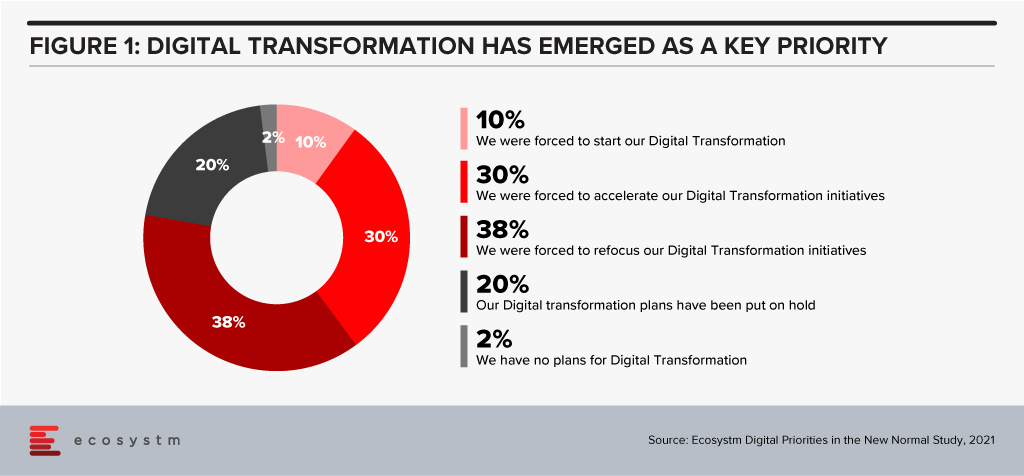People management has always posed challenges for businesses and their HR leaders. Leaders have to address skills shortages, develop strategies to attract and retain talent, and promote inclusiveness in their policies. Today’s digital landscape – where there is a scarcity of digital skills across industries – makes it even harder. Leaders are now paying close attention to employee experience and retention, and topics such as digital workplace, hybrid work, flexibility, and wellness have made it to management discussions.
At the Leaders Dialogue: Asian Sentiment 2023 conversation, Ecosystm Founder and Chairman, Amit Gupta; Ahmed Mazhari, President of Microsoft Asia; Padmashree (Paddy) Santosh, VP & Global Head of Learning, Diversity and Organisation Effectiveness at Olam Agri; and Luca Destefanis, Head of Marketing APAC at Kyndryl discussed where Asia is facing their biggest challenges in talent management and how to mitigate them.
Here are the key takeaways:
- Digital skills shortage is real
- Purpose empowers employees
- The ‘Productivity Paradox’ needs addressing
- Hybrid Work is the accepted norm
- Technology & Culture differentiate the employee experiences
- Getting workplace transformation right is crucial
Read on to find out more about the future of talent in Asia.
Download The Talent Conversation as a PDF

November has seen uncertainties in the technology market with news of layoffs and hiring freezes from big names in the industry – Meta, Amazon, Salesforce, and Apple to name a few. These have impacted thousands of people globally, leaving tech talent with one common question, ‘What next?’
While the current situation and economic trends may seem grim, it is not all bad news for tech workers. It is true that people strategies in the sector may be impacted, but there are still plenty of opportunities for tech experts in the industry.
Here is what Ecosystm Analysts say about what’s next for technology workers.

Today, we are seeing two quite conflicting signals in the market: Tech vendors are laying off staff; and IT teams in businesses are struggling to hire the people they need.
At Ecosystm, we still expect a healthy growth in tech spend in 2023 and 2024 regardless of economic conditions. Businesses will be increasing their spend on security and data governance to limit their exposure to cyber-attacks; they will spend on automation to help teams grow productivity with current or lower headcount; they will continue their cloud investments to simplify their technology architectures, increase resilience, and to drive business agility. Security, cloud, data management and analytics, automation, and digital developers will all continue to see employment opportunities.
If this is the case, then why are tech vendors laying off headcount?
The slowdown in the American economy is a big reason. Tech providers that are laying of staff are heavily exposed to the American market.
- Salesforce – 68% Americas
- Facebook – 44% North America
- Genesys – around 60% in North America
Much of the messaging that these providers are giving is it is not that business is performing poorly – it is that growth is slowing down from the fast pace that many were witnessing when digital strategies accelerated.
Some of these tech providers might also be using the opportunity to “trim the fat” from their business – using the opportunity to get rid of the 2-3% of staff or teams that are underperforming. Interestingly, many of the people that are being laid off are from in or around the sales organisation. In some cases, tech providers are trimming products or services from their business and associated product, marketing, and technical staff are also being laid off.
While the majority of the impact is being felt in North America, there are certainly some people being laid off in Asia Pacific too. Particularly in companies where the development is done in Asia (India, China, ASEAN, etc.), there will be some impact when products or services are discontinued.

While it is not all bad news for tech talent, there is undoubtedly some nervousness. So this is what you should think about:
Change your immediate priorities. Ecosystm research found that 40% of digital/IT talent were looking to change employers in 2023. Nearly 60% of them were also thinking of changes in terms of where they live and their career.

This may not be the right time to voluntarily change your job. Job profiles and industry requirements should guide your decision – by February 2023, a clearer image of the job market will emerge. Till then, upskill and get those certifications to stay relevant!
Be prepared for contract roles. With a huge pool of highly skilled technologists on the hunt for new opportunities, smaller technology providers and start-ups have a cause to celebrate. They have faced the challenge of getting the right talent largely because of their inability to match the remunerations offered by large tech firms.
These companies may still not be able to match the benefits offered by the large tech firms – but they provide opportunities to expand your portfolio, industry expertise, and experience in emerging technologies. This will see a change in job profiles. It is expected that more contractual roles will open up for the technology industry. You will have more opportunities to explore the option of working on short-term assignments and consulting projects – sometimes on multiple projects and with multiple clients at the same time.
Think about switching sides. The fact remains that digital and technology upgrades continue to be organisational priorities, across all industries. As organisations continue on their digital journeys, they have an immense potential to address their skills gap now with the availability of highly skilled talent. In a recently conducted Ecosystm roundtable, CIOs reported that new graduates have been demanding salaries as high as USD 200,000 per annum! Even banks and consultancies – typically the top paying businesses – have been finding it hard to afford these skills! These industries may well benefit from the layoffs.
If you look at technology job listings, we see no signs of the demand abating!

As technology vendors, their channel partners and organisations deal with the tech talent crunch, there are consequences for the entire technology ecosystem. Vendor solutions are less impactful than their potential; their channel partners are losing a lot of time in closing sales cycles and their customers are left with sub-optimal deployments.
Here is how vendors and their channel partners can bridge the gap:
Re-evaluating Certification Programs
The first step is to move to a case-based training model with the participant needing to respond to a situation rather than answering multiple-choice questions. We do not discount the usefulness of standard testing, but it needs to be mixed with evaluating the situational awareness and subjective understanding of the participant. This will require more detailed answers and case studies and will require a knowledgeable evaluator at the other end who will need more time than that required to assess MCQ answers. While AI tools are starting to address this, for now, this means a fairly large investment in resources.

While giving the tech talent – whether Sales or Delivery – a greater context of competitors’ strengths will give them a better chance to win deals, it has the potential to open up a host of issues that are best avoided. However, part of that knowledge can be provided as a general solution context – focusing on customer benefits in doing a certain transition and the kind of use cases that would be most appropriate for each transition. This will require, in most cases, a redesign of the curriculum.
Rethinking Partner Sales Support
A much bigger initiative by the vendors could be to set up sales support specialist groups within their own organisations that can be booked for customer meetings by channel partners. This has become easier now with most organisations being quite accustomed to video conferences and virtual meetings.
The set-up of such a “centre” will require careful planning, expertise, and investment in systems. Most vendors do have something like this for escalations and technical support, but few have a comprehensive program to assist with sales opportunities.

The resources at these centres should be highly specialised and well-paid. This will add cost. However, a group like this can pay for itself as long as more deals are converted. We do not recommend using gold-plated costs, but penny pinching, especially on the quality of resources and systems used here will be a classic case of penny wise, pound foolish. Success here will come from increasing revenue, not decreasing cost.
Clarifying Hiring Policies
Finally, vendors need to be clear about the policies of hiring staff from their channel partners. It is unlikely that this practice is going to stop. For one, if they don’t hire these talents, their competitors might. And channel partners often attract more talent if they are able to hold out the carrot, that the employee can eventually get employed by the vendor.
However, there should be clearer policies, such as only hiring those who have spent a minimum specified time with the partner; providing a longer than normal off-ramp period; seconding the talent to the channel partner for a period during which the employee gets additional training on the vendor’s solutions while working for the channel partner. Incentivising channel partners for providing successful candidates might also be a good idea.
Having bad policies, an attitude of poaching or not cooperating just leads to the channel partners underinvesting in people which harms the vendor as well as the channel. Innovative strategies here can deliver a solution where the channel partner is able to attract better talent and manage the talent while they are in their formative stages. Essentially, they are rewarded for incubating talent. The best talent eventually “graduate” to working for the vendor. This will be a true win-win for both.
Making Upskilling a Norm
The leadership of channel partner organisations need to embrace upskilling of their teams. Employees need technological capability building as well as certification.
Upskilling is a slower burn process than some of the steps discussed earlier, but for partners, this is the key. Partners will need help to put together a full program that nurtures employees at different levels of experience and capability and builds them up with a step-by-step approach. This is actually the job of a full-fledged Learning and Development organisation. Very few partners today either invest in such an organisation or have the ability to work this into their HR practices.
Finding an outsourced partner who can help to design and implement such a program might be the way to go. There is also an opportunity here for multiple channel partners to coordinate and engage one agency, in effect paying to hire an outsider as a joint Chief Learning Officer for all their companies.

In an exploding market where the skill of the employee can land the extra contracts, reel in the customers, whose lifetime value can be enormous, upskilling is vital – it is not really a choice.
Conclusion
There is a need to do things differently and to invest a lot more in talent. In a growing market, channel partners are getting by as revenue is moving upwards anyway. A smart step-by-step investment approach, however, can dramatically change this growth trajectory. That will alter the fortunes of the vendors too. Maintaining the status quo and not spending more on tech talent is actually a poison pill – the market growth is just hiding that fact.

As the world has had to cope with a scenario never seen before in modern times, technology has been at the forefront of the response. This means hardware – computers, servers and the like – flew off the shelves. Cloud infrastructure and migration have been top of mind. “Digital Transformation” and the adoption of digital tools is expanding like a house on fire! We found that over 3 in 4 companies accelerated their digital plans in some way. Another 20% put plans on hold, largely because they felt the need to evaluate the old plans which became inadequate.

As vendors, channel partners and organisations scramble to put their new digital houses together and build the best digital castles possible, there is a major talent crunch. There are few who can deeply understand customer needs and recommend the right solution. While this affects all parties, the channel partners are feeling this more acutely. In my recent conversations with channel partners, it became evident that they are facing difficulties in finding and retaining good Sales and Solutions talent. There have also been complaints about talent being poached by the tech vendors they partner with!
The standard response to this problem is vendor certification and training. However, this is inadequate, due to three main reasons.
The Pace of Technological Change
The latest technology and what is possible with it changes on almost a daily basis. In this environment, for a person to keep up with everything is almost impossible. The ways in which a specific technology can be applied and the solutions it can deliver change, based on the ecosystem that forms around the technology and with the improvements in capability with time.
Small changes in different applications can cascade to create a solution (in terms of meeting a user need) which was not possible a short time ago. This may then compete with a completely different technology that has been considered satisfactory till date for the same user need. If the new option performs better, the old option is gone before you can snap your fingers.
For a salesperson to be across all this requires a solid understanding of the industry and its environment at a conceptual level. Given the pace of change, such people have become increasingly rare. They can be trained on a specific technology, not on perspectives, conceptual clarity or industry depth – that would require a formal degree!
The Limits of Lecture Style Training

Unfortunately, there is a key shortcoming in the whole certification program. A person going through any kind of classroom type training is limited in how much they can understand. This includes any kind of knowledge download or dump – videos, online courses, virtual classrooms, reading, webinars or physical classes. With technology that changes every day, the depth of knowledge imparted through such knowledge downloads is woefully inadequate. Expertise in technology is difficult to attain without getting one’s hands dirty.
Trying to make the training more “practical”, involving more exercises is good and does lead to better-trained personnel. But this is a long process and does not fit in with the timelines of most certification programs.
An actual customer implementation is probably the best teacher available right now. However, this leads to an unintended consequence – channel partners tend to stick with the vendor solutions that they have implemented before. Even if they can partner with other tech providers for better options they prefer to stick to what they know.
Vendor Bias in Training Programs
Certification is done, quite understandably, from the vendor’s point of view. The program is not built to generate an understanding of the tech world that we live in. That is taken as a given. Expertise in the vendor’s solution is the focus, and rightfully so. Talking points refer to that solution’s strengths and gloss over the weaknesses. There is no reason for a vendor to teach the participant the advantages of the competitor’s technology. Or explain the shortcomings of their own.
When the certified salesperson, however, is in front of the customer, this certification does not help them address all the queries. They are unable to clear the doubts or provide a complete (and objective) view that would satisfy a probing customer.
But there are ways in which this skills gap can be bridged – it will require both vendors and their channel partners to change how they view and grow talent. Stay tuned for the next feature where I share how the tech talent landscape can be changed.

As the economy looks to recover from the devastating impact of COVID-19 in 2020, businesses in Singapore are gaining momentum through technology leverage, and wider adoption of digital platforms. The disruption has led to a higher dependence on and appetite for technology to rebuild industries such as Healthcare, Financial Services and Manufacturing. Organisations are re-engineering their processes to go digital and this has driven the need to re-skill and upskill.
Growing Need for Tech Talent
Even before the pandemic, there was a shift of business focus on the Asian and Southeast Asian economies, that has led global companies and investors to flock to Singapore as a regional hub. Many of these companies are technology providers and as Singapore looks well-positioned to recover from the pandemic, these companies find themselves delivering on multiple transformation projects across industries. This has led to an increased demand for tech experts, The growing demand, combined with travel restrictions and a focus on ensuring Singaporeans are a priority for employment opportunities, has made the tech community anxious about the talent availability and the possibility of a talent crunch.
Ecosystm Principal Advisor Ravi Bhogaraju says, “Tech talent crunch is very palpable in the Singapore market today. The primary drivers of the crunch have been the change in the immigration policies due to the COVID-19 disruption followed by the huge increase in the demand for technology skills in the last 12-18 months. This gap will continue to rise over the next years as more technology firms expand or set up their base in Singapore.”
Skill Development Efforts and Programs
With this in mind, the Government of Singapore is focused on addressing this concern through various innovation and skills development programs. For instance, the Economic Development Board (EDB) has introduced programs to grow the talent pool, partnered with institutions and organisations for reskilling programs and supporting skills development with help of other companies.
Some more Government-supported initiatives to bridge the skills shortage include Singapore’s Global Ready Talent Programme (GRT) which aims to build talent pipeline by exposing Singaporeans to internships and work opportunities overseas, TechSkills Accelerator (TeSA) and Professional Conversion Programmes (PCP), to provide training on knowledge and skills to support expansion plans.
The Government has also increased its spending on digital initiatives to help SMEs and empower them to hire more specialised manpower in focus areas such as AI, cloud, IoT, and data analytics.
Singapore’s Tech.Pass visa program is another initiative to invite qualified individuals to work and operate in Singapore. It supports the entry of up to 500 proven founders, leaders and experts from top tech companies into Singapore.
Bhogaraju says, “The skills gap needs to be bridged with talent that is ready to step up and take on the new roles. To that end we see that the Singapore Government is making the right investments in the Skills Future program. There are a few pillars currently in play that are addressing different elements of the talent skilling initiatives. The key pillars are talent reskilling, experiential training, work-learn programs, and implementing new education curriculum. These are well designed in line with the skills frameworks and are meant to address the skills development for mid-career professionals to students in polytechnics and university programs.”
Tech Companies Need a Long-term View
However, Bhogaraju notes, “That’s only one side of the equation – the other element of the partnership is the companies that need these skills and how they are thinking of approaching the skills they need. Here there are some good examples of public private partnerships to help bridge the skills. However, in many cases the companies are still struggling to fill the positions – and that is because they use an age-old strategy of ‘let’s attract the talent’ to come work for us. In a time when there is limited talent in the pool – this strategy will only result in spinning wheels and expending energy.”
“Companies need to fundamentally rethink their talent pooling and development strategies to be able to deliver good quality talent. They need to develop a strategy that focuses on reskilling, finding new talent pools, leveraging the gig economy and developing their existing talents into adjoining pools to be able to fill these gaps effectively.”
As the nature of work transforms, many professionals will be challenged to learn new skills to address the skills gaps. Create your free account on Ecosystm Platform to access research, data and insights on the emerging technologies, the supply of skills and the demand for tech talent to address the mismatch.

















